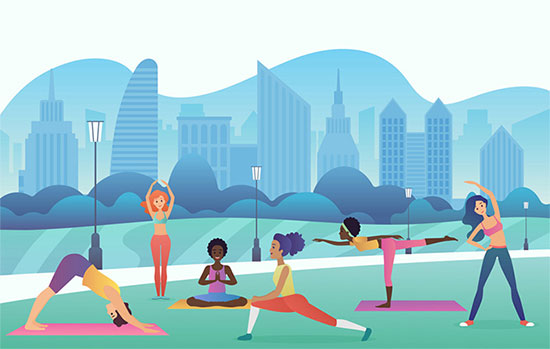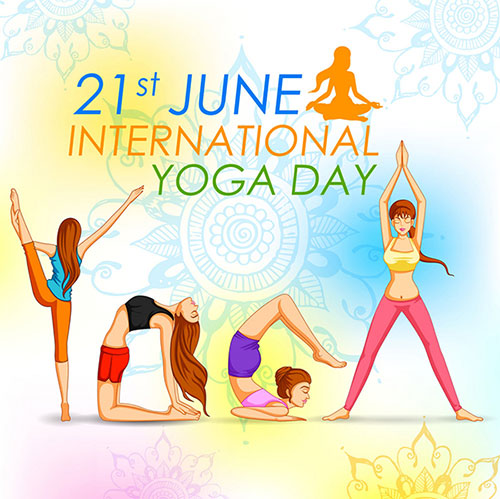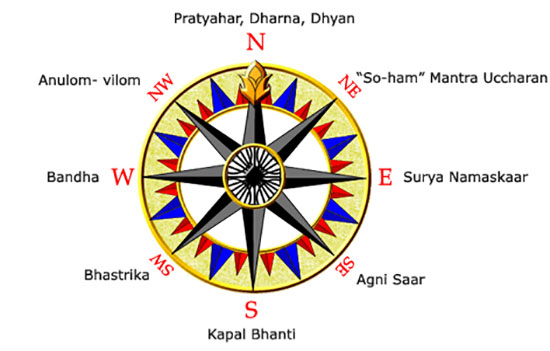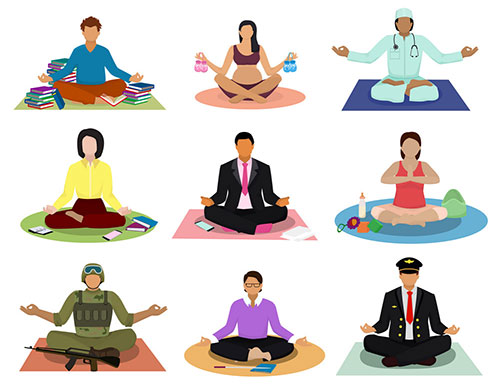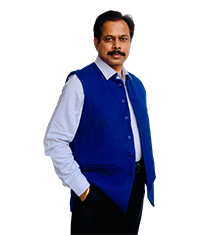VAASTU YOGA
Patanjali Yoga
Patanjali, the exponent of Yoga Shastra has integrated the entire Yoga Shastra into various sutras, which circle around Samadhi (reconciliation), Sadhana (means), Vibhuti and Kaivalya. In the first part, reconciliation to achieve control of mind and the means to perfect reconciliation have been discussed.
FOR VASTU NUMEROLOGY COURSES - CLICK HERE
FOR VASTU COURSES - CLICK HERE
In the second part, Ashtaang Yoga, which is required to achieve reconciliation, has been discussed. In the third part, Vibhutis of Yoga and in the fourth part, establishment of Kaivalya have been discussed.
Ashtaang Yoga has an important role in the perfection of Yoga. These eight parts of Yoga are as follows -
-
Yama (restraints).
-
Niyam (regulations)
-
Aasan (postures)
-
Pranayaam (control of breath)
-
Pratyaahaar (restraining of sense organs)
-
Dhaarna (contemplation)
-
Dhyaan (meditation)
-
Samadhi (reconciliation).
YAMA (restraints):
Non-violence, truth, not stealing the wealth of others, celibacy and renunciation, these are five parts of Yama or restraints.
Ahimsa (non-violence): Not tormenting any creature through our mental, verbal and physical action. Non-violence is a very powerful virtue. In the company of a true non-violent Yogi, even the snake and mongoose give up their natural hostility.
Satya (Truth): Mind must think without jealousy and craftiness and the words should reflect this state of mind truly.
Asteya (not stealing the wealth of others): Mind must not think about the wealth of the others, eyes must not see the wealth of the others and the body must not make efforts to steal the wealth of the others.
Brahmacharya (celibacy): Mind must not think about women, eyes must not see the women and the body must not make efforts to come in contact with women. Celibacy preserves semen- the wonderful force of creation and thus helps Yogi to achieve extra-ordinary perfection.
Aparigraha (Renunciation): Non-accumulation of things that provide comforts in the way of sight sound, smell, taste and touch as well as controlling the desire of getting others? wealth. When a Yogi achieves perfection in renunciation, he automatically comes to know about his own past, present and future births as well as those of the others.
NIYAM (regulation)
Regulation too has five kinds- purity, satisfaction, expiation, recitation and devotion. Shaucha (purity): Purity is of two kinds- external and internal. External purity involves cleansing of body through water and soil, of conduct through desertion of selfishness and of food through consumption of plain edibles earned through just means. Internal purity involves cleansing of inner self through cultivation of pious feelings. It also involves destruction of self-defeating feelings like ego, anger, jealousy, fear, lust etc. Through the practice of purification means, mind feels happy and concentrates easily.Santosh (satisfaction): Always being happy with what one has received and remaining sated in favourable and unfavorable situations are the features of satisfaction.
Tapa (expiation): Expiation begins from the mind when one learns to control the ever- conflicting thoughts. With that, a Yogi develops the capacity to tolerate hunger and thirst, coldness and heat etc.
Swadhyay (Reading and reciting): Reading of benevolent scriptures and reciting the name of almighty God are included in this head.
Pranidhaan (devotion): Devotion involves dedicating our every action- mental, verbal and physical at the feet of God. Devotion helps one to win his ego and is an efficient means to practice reconciliation.
ASANA (postures)
Gestures in which a Yogi can sit for long without straining his limbs is what we call as postures or Asanas. In a particular posture, arms, legs and other parts of the body are kept in a comfortable position without feeling least pain. When a Yogi achieves perfection, he can sit up to three hours in a posture continuously. Postures are good means to control the body and make it indifferent to the effects of heat and cold. Some of the prominent Yogic postures have been described here.
SURYA NAMASKAR (SALUTE TO THE SUN)

Surya Namaskar is included in the regular routine of prayer and worship. Means it must be practiced regularly. It's greater importance has been described in the scriptures. As per the scriptures, a single day worship of the sun has virtues equivalent to the bestowal presentation of one lakh milk cows. Like worship, Surya Namaskaras too has their own significance. Surya Namaskara means prayer (Vandana) of Lord Surya. Surya Vandana is short. Surya Namaskara is an ancient system of Indian exercise. Stand facing the east at dawn and peacefully chant the mantras to pray Lord Surya and offer red sandals, flowers, rice grains (Akshatas) with water of simply the water alone as ARGHE (libation) and perform Surya Namaskara. This whole process must be performed before the sunrise. |
|
Now recite the following Mantra to pray Lord Surya. NAMASKARA |
|
|
|
Raising the arms up, stretch whole of your body backward while gazing the sky with open eyes. Ben backward as mush as possible, expand your chest at the same time. BENEFITS :Both the shoulders and the food pipe (Esophagus) get exercise and diseases related them are corrected. Eyesight is also improved. 
BENEFITS : 
BENEFITS : 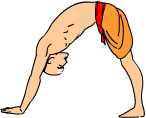
Procedure: Inhale the breath deeply and hold it and pull both of your legs backward, so that the thumbs of the feet, ankles and knees touch each other. Stabilizing the feet and keeping the head, waist, the back and the elbows in a line bend forward and resting both the palms on the ground keep your body like a bow. Procedure: Holding the breath, rest both of your knees on the ground. Touch the ground with your chest and touch the lower part of the neck with chin. Also touch the ground with the upper part of the forehead and the nose. Please note that the abdomen should not touch the ground. It should be pulled in. Exhale the breath now, Both the hands (palms) must be kept on the sides of the chest (Fig.) 

Repeat the process of Bhudharasana as described in the step six (6) 
Repeat the process of the fifth Namaskara as described in the step five (5) just reverse the position of the legs. 
Repeat the process described in the fourth Namskara, step four (4). |
|
PRANAYAMA - A SCIENCE OF BREATHING YOGA
| Meaning of Pranayama: The literal meaning of Pranayama is Prana’s ayam that is an extension of the Prana. The vital life force. ‘Tasmin ati shwas prashwas yogati vichehhedah pranayamah’. That is, Pranayama is nothing but a retention of the Prana-the vital life-force breath through break in the rhythmic breathing. Prana is that vital life force which seems to be controlling every thing on this tangible earth, and exist as a thought in the world. In other words, the prana is related to the mind and mind is related to the brain and the brain is related to the soul (Atma) and the soul (Atma) is ultimately related to that eternal divine force called Paramatma. Thus the objective of Pranayama is to stimulate, communicate, regulate and control the vital life force that exist in the body. Importance of Pranayama : Tapo na param pranayamati, Tata vishuddhirmalana diptishch gyanasya". That is no other Tapa or penance greater than the Pranayama. It helps in removing the blemishes and also helps the knowledge to rise. DAHYANTEDHMAYMANANAM DHATNNAM MIYATHA MALAH TATHENDRIYANA DAHYANTE DOSHAH PRANASYA MIGRAHAT That is, as the stage of a metal is removed or destroyed by heating it in fire, smimilarly the blemishes of the senses of the body are remove by practicing Pranayama. Thus, the Pranayama is very important for uprooting the evil thoughts that accumulate over a long time in the mind and hence refining the mind.
Essential Knowledge about Pranayama In order to practice Pranayama fully and effectively, the learner must strictly follow the following things:PLACE: The place for performing Pranayama must be isolated and airy with ample ventilation. In order to perform Pranayama in best way, pure veins and arteries are essential.Hence it is said NARI SHUDDHIM CHA TATPASHCHATE PRANAYAMAM CHA SADHAYETA Meaning: Practice Pranayama only after purifying your veins. To purify the veins, first practice the postures (Asanas). Pranayama must be practiced punctually at the fixed time with empty stomach. After the ten minutes of finishing Pranayama, take a glass of milk.In line with, Excess of everything is bad. Never practice Pranayama excessively to the point of dropping you must feel fresh, and active after each session of Pranayama.
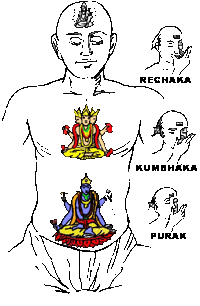 Method of Pranayama: To practice Pranayama, the left and the right nostrils are to be closed successively. This is mostly done with the help of the right hand. Using the right hand’s thumb, right nostril is closed, while the left nostril is closed with the help of the ring and little fingers of the same hand. When the nostrils need not be closed put both the hands on your knees. Practice Padamasana, Siddhasana, Swastikasana and Sukhasana as far as possible to perform Pranayama. |
|
Meanings of these three terms are thus :
These are three nerves through which flows the life. The moon, the sun and the fire are the gods of these three nerves respectively. Ida flows via left nostril, and Pingla flows via right nostril, while Sushumna flows via both the nostrils. Hence Sushumna is also called as the middle nerve. Ida and Pingla keep on changing the tone every hour.
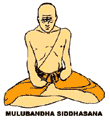 MULABANDHA, JALLUNDHAR BANDHA & UDDIYANA BANDHA MULABANDHA, JALLUNDHAR BANDHA & UDDIYANA BANDHADuring Pranayama, these three Bandhas are used. The methods and the benefits of them are thus :
Press the suture at groin region with the heel of right foot and put the heel of the left foot at the base of the reproductive organs. Contracting the anus, pull it forcibly in towards spinal cord and feel as if you are trying to pull the wind in your belly upward. Position of the feet can be interchanged. (Fig.) BENEFITS :
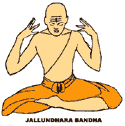
Method:- First of all take a sitting posture Contract the throat then and bend the head forward, and rest the chin firmly at the chest. BENEFITS : Method:- This bandha can be practiced both in standing posture and in sitting posture. It standing posture put your hands on the knees or slightly above the knees on the thighs. Bend your body a little forward while keeping a gap between your feet. Exhaling forcibly, empty your lungs. Contracting the belly, pull the navel and intestine towards your back. Thus your diaphragm will be pushed up and the wall of the belly will be also be pulled upward. This Bandha is practices at the end of Kumbhaka (retention of breath) and beginning of Rechaka (exhalation of breath). (Fig.) BENEFITS :
|
Arteries and veins, through which the blood flows in the body, can be purified by practicing Pranayama. For this purpose the Pranayama that is practiced is ANULOM-VILOM Pranayama. A common learner must begin the practice of Pranayama with Anulomvilom. Being simple in nature, even common people also easily practice Anulomvilom Pranayama.
Method :
Sit down in Padmasana or Siddhasana. Close your right nostril with your right hands thumb and inhale through left nostril as long as you can easily inhale. When your lungs are full, close both the nostrils and hold the breath for some time. Then slowly exhale through the right nostril closing the left. Thereafter close your left nostril and inhale through the right nostril and then closing both the nostril holds the breath in your body and ultimately exhale the breath through your left nostril. Thus you finish one cycle (Avartana) of veins purifying Pranayama. Practice three or four Avartanas daily and increase this practice slowly. Once practiced well, practice this Pranayama in the ratio of 1:2:2, That is inhale for four seconds; hold the breath for eight seconds and then exhale the breath in eight seconds. Increase this ratio slowly upto a ratio of 5:20:10.
- It’s an excellent method to perform Pranayama that does away with the lung’s diseases.
- Through this Pranayama, the blood gets an increased amount of life giving oxygen that thoroughly cleans and purifies it.
KAPALBHATI (GLOWING OF SKULL)
Kapal is a Sanskrit word that means skull, while Bhati means lighting or glowing. Thus Kapalbhati is such a kind of Pranayama, practicing which the skull begins to glow.
Method :
Sit down in Padmasana or Siddhasana. Rest both of your hands on the knees, and close the eyes. Now like the blower of a blacksmith, begin to perform Puraka and Rechaka (inhaling and exhaling of breath). This exercise must be performed laboriously. There is no Kumbhaka or holding of breath stage. Inhalation and exhalation of breath play the all important role. Your nerves will reverberate in this exercise and you will sweat profusely. It is an extremely powerful exercise performing which all of your cells, neurons and nerves vibrate rapidly.
In the beginning, exhale only once per second. Increasing your speed slowly then exhale twice per second. Initially practice a cycle of ten exhalations. Increase the number of exhalation slowly.
Benefits :
- Kapalbhati clears your skull, respiratory tract and the sinus.
- Destroying the cough that clogs the trachia Kapalbhati leads to the cure of asthma.
- By practice of Kapalbhati, air cells in the lungs receive ample amount life giving oxygen, hence germs of diseases like tuberculosis cannot harm them.
- Carbon dioxide The gaseous waste of respiration process is exhaled out in large amount thus purifying the blood.
- This process also activates the heart and enhance the capacity of the respiratory system, circulation system and digestive system.
KINDS OF PRANAYAMA :
Among the many kinds of Pranayama. i.e. Kumbhaka, eight kinds are considered as main. These are (a) SuryaBhedan, (b) Ujjayi, (c) Sitkari, (d) Shitali, (e) Bhastrika, (f) Bhramani, (g) Murchha and (h) Plavini
- SURYA BHEDAN :
- With regular practice of this Pranayama, the mind is refined, and intestinal germs and diseases caused by wind, are destroyed.
- This Pranayama awakens Kundalini power, as a result of which, appetite is also stimulated.
- Rheumatic and other wind caused diseases are corrected. To get rid of the blood disorders, skin diseases and leprosy, This Pranayama is excellent.
- It strengthens the liver, which then begins to secret bile in ample quantity.
- UJJAYI
- With this Pranayama, the warmth of the head is reduced, and lung diseases like asthma, tuberculosis etc. are cured.
- It kindles your appetite and enhances the capacity of digestive systems, respiratory systems etc.
- SITKARI
- With practice of sitkari Pranayama effects the hunger, the thirst, the laziness and the sleep are removed.
- It prevents the bile from increasing.
- Hardness of the tonsils is also removed by it.
- With regular practice of the Pranayama the mental and physical powers of the performer increase.
- SHEETALI
- The Pranayama expels the toxins that accumulate in the blood, and thus purifies the blood.
- Diseases like tumor, jaundice,skin diseases, fever are cured, and it also corrects indigestion and constipation.
- It quenches the thirst. Hence if for any reason getting water is impossible at some place, and you are feeling thirsty you may quench the thirst through this Pranayama.
- With regular practice of this you may become immune to the snakebite and Scorpio’s stings.
- For the people who lose temper easily and get excited quickly this Pranayama is highly beneficial.
- With this Pranayama uncontrolled growth of placenta, liver, spleen and disease like gangrene, leprosy etc. are corrected.
- BHASTRTIKA
- With the practice of Bhastrika, swelling of the throat is corrected, appetite is kindled and the cough is removed. Diseases of the nose and chest like asthma, tuberculosis etc. are also corrected.
- Diseases caused by imbalance of wind, cough and bile (Vata, Cough and Pitta) are also corrected by this Pranayama.
- If no other means to warm the body is available, it can be heated with the help of this Pranayama.
- Pores of Sushumna nerve are opened by Bhastrika.
- BHRAMARI
- The mood feels elevated, with increased flow of knowledge and the asceticism begins to appear.
- With successful practice of Kumbhaka the performer enters successfully the stage of trance (Samadhi)
- MURCHHA (Unconsciousness)
- The mind becomes free of all the feelings and the performer experiences joy.
- Through this Pranayama, thoughts and resolution decreases in the mind,and a person experiences the feeling of non-existence that is the mana becomes Amana and annihilates in ethereal energy called Parmatma.
- PLAVINI
- Expert of Plavini Pranayama can sustain his life for many days without food.
- During the practice of this Pranayama the blood flows in the body extremely speedily thus removing the impurities and toxins accumulated in the body.
- With practice of this Pranayama, the performer gains the power to float on the water. An expert can even remain floating on deluging waters like a light lotus leaf.
Surya bhedan means pricking of Pingla nerve that is the nerve of the sun. Thus, the main aim of this Pranayama is to awaken Pingla nerve. As a result of this Pranayama, that part of the brain which is the abode of masculine power (Shiva), is awakened practice of Surya Bhedan causes a lot of heat to generate in the body, hence practice of this Pranayama is more beneficial in winters.
Method :
Sit in Padmasana or Siddhasana and close your eyes. Now close the left nostril with the little finger of your right hand and inhale as deeply as you can through your right nostril then close the right nostril with the thumb of right hand and resting the chin on the chest, retain the breath. Increase the interval of breath retention (Kumbhaka) slowly then closing your right nostril with the thumb of right hand silently exhale the breath you have so far retained Repeat the process again.
Benefits :Note : People affected with diseases must perform this Pranayama in winters or rains under mild sun.
Method :
Sit in Padmasana or Siddhasana. Close your mouth. Contract the inner part of the tongue and the wall of throat facing it. Now inhale the breath through both the nostrils equally and fill your chest. Then retain the breath as long as you can do comfortably. Ultimately closing right nostril with right hand’s thumb, exhale slowly through the left nostril. Expand the chest while you are inhaling the breath. The speed of inhalation must not vary.
Note : It is better to practice this Pranayama in winters.
Method :
Sit in Padmasana and Siddhasana and roll the tongue upward in such a way that it’s tip touches the upper palate and it’s mid part touches the lip. Now suck in the air with an audible. Si..S-..Si.. sound. Then retain the breath as long as possible. Ultimately exhale the breath through both the nostrils.
Method : Sit in the Padmasana, Siddhasana or Vajrasana. Protruding the tongue roll it along the sides so that it takes the shape of blowpipe. Now suck in the air and retain it inside your lungs as long as possible. Ultimately exhale the breath through both the nostrils.
Benefits :Blower in Sankrita is called as Bhastrika. Hence exhalation of breath forcibly and quickly is the main feature of Bhastrika Pranayama. One should inhale and exhale breath like a blower. It is in a way a combination of Kapalbhati and Vjjayi. Among all the Kumbhakaras, this Pranayama is considered the best.
Method :
Sit in Padmasana and Siddhasana stretch your head, neck and back. Put your hands in lap or on the knees. Inhale and exhale rapidly your or five times like a blower. Similarily contract and expand the lungs. A peculiar rusting sound will be produced during the practice of this Pranayama. But the performer must practice this Pranayama rapidly and without stopping even once. At the completion of one cycle (Avartana) the performer must inhale breath as deeply as possible and retain it as long as possible. Ultimately exhale as much breath as possible. Thus a cycle (Avartana) of Bhastrika completes. After resting a while, perform another cycle of this Pranayama. Perform three cycles of the Pranayama in a go. If not possible, perform only single cycle. Perform this Pranayama twice-once in morning and evening each in winters, and only once a day in summers.
The name of this Pranayama originates from Sanskrit word Bhramar that means bumblebee. While performing this Pranayama a buzzing sound, typical of bumblebee is produced from the nostrils.
Method
Sit down in Padmasana or Sidhasan. Now inhale and exhale breaths rapidly through both the nostrils with a buzzing sound that is similar to the buzzing of bumble bee. Keep on doing this exercise till you sweat profusely. End the exercise with inhaling the breath through nostrils as deeply as possible and hold it as long as you can. Then exhale through both the nostrils. As you increase the speed of inhalation and exhalation of breath, The speed of blood circulation will also increase, leading to generation of heat in the body and profuse sweating and as you know evaporating sweat will cool down your body and you will experience hilarious or joyful sensation.
Without practicing Anulom-Vilom Pranayama first, This Pranayama would not yield desired benefits.
Through this Pranayama the performer attains Murchhavastha the state of unconsciousness or coma and his mind becomes free of all the feelings. Hence this Pranayama is called as Murchha.
Method :
Sit down in Posture that best suits you and inhale breath through both the nostrils. Then retain the breath with the help of a powerful Jallundharbandha. Ultimately exhale the breath through both the nostrils.
Benefits :
Plavini has originated from the Sanskrit word PLU that means to float. Thus Plavini means the one that causes to float.
Method:
In the beginning practice this Pranayama in Siddhisana or Vajrasana. With practice you can perform it in standing or lying posture as well. If you are performing it in sitting posture, inhale the breath through both the nostrils and retain it by Jallundharbandha. When you take Jallundharbandha, the retained air fills the intestines, which get inflated as a result. End the Pranayama with exhaling the breath through both the nostrils. If necessary, remove the air that is trapped in the intestines by balancing or Uddiyanabandha.
Benefits :
Note :
For the perfection of this Pranayama, slow but continuous and regular practice is extremely essential. Hence practice is extremely essential. Hence practice this Pranayama in the guidance of an expert teacher only.
CLICK HERE for Yoga and Meditation Remedies for Vaastu-Dosha
Er. Rameshwar Prasad invites you to the Wonderful World of Vaastu Yoga
Engineer Rameshwar Prasad(B.Tech., M.Tech., P.G.D.C.A., P.G.D.M.) Vaastu International
|

